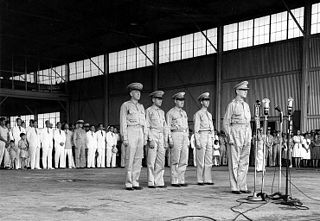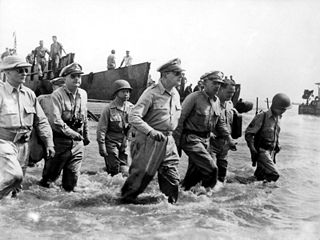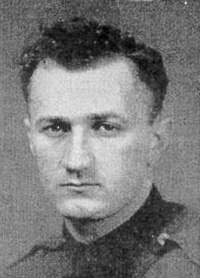
United States Army Forces in the Far East (USAFFE) was a military formation of the United States Army active from 1941 to 1946. The new command's headquarters was created on 26 July 1941, at No. 1, Calle Victoria, Manila, Luzon, the Philippines, with General Douglas MacArthur as commander. The Chief of Staff was Brigadier General Richard K. Sutherland and the Deputy Chief of Staff was Lieutenant Colonel Richard J. Marshall. The core of this command was drawn from the Office of the Military Advisor to the Commonwealth Government of the Philippines.

The Hukbong Bayan Laban sa Hapon, better known by the acronym Hukbalahap, was a Filipino communist guerrilla movement formed by the farmers of Central Luzon. They were originally formed to fight the Japanese, but extended their fight into a rebellion against the Philippine government, known as the Hukbalahap Rebellion, in 1946. It was put down through a series of reforms and military victories by Defense Secretary, and later President, Ramon Magsaysay.

Wendell Fertig was an American civil engineer, in the American-administered Commonwealth of the Philippines, who organized and commanded an American-Filipino guerrilla force on the Japanese-occupied, southern Philippine island of Mindanao during World War II. Fertig's widely scattered guerrilla force numbered approximately 32,000. He faced about 50,000 Japanese soldiers, mostly garrison troops in towns and cities.

Kabacan officially the Municipality of Kabacan, is a 1st class municipality in the province of Cotabato, Philippines. According to the 2020 census, it has a population of 77,164 people.

The Philippines campaign, Battle of the Philippines, Second Philippines campaign, or the Liberation of the Philippines, codenamed Operation Musketeer I, II, and III, was the American, Mexican, Australian and Filipino campaign to defeat and expel the Imperial Japanese forces occupying the Philippines during World War II.

Ruperto Cadava Kangleón was a Filipino military officer and politician. He was a native of the municipality of Macrohon in the province now named Southern Leyte.

Robert Lapham was a reserve lieutenant in the US Army in World War II. He served in the Philippines attached to the 45th Infantry, evaded capture in the spring of 1942, and organized and led one of the largest and most successful guerrilla armies on the central plains of the northern island of Luzon. He was promoted to major by war's end, age 28, and was awarded the Distinguished Service Cross by General Douglas MacArthur. Lapham was the third person, after President Franklin Delano Roosevelt and MacArthur, to receive the Philippine Legion of Honor. Historian Norling says that Laphams's Luzon Guerrilla Army Force (LGAF) was probably the most efficient of the many guerrilla armies on Luzon. The U.S. Guerrilla Affairs Division commended Lapham for having the best-disciplined guerrilla organization.

The Japanese occupation of the Philippines occurred between 1942 and 1945, when the Japanese Empire occupied the Commonwealth of the Philippines during World War II.
Iliff David "Rich" Richardson was simultaneously a US Navy ensign and a US Army major while fighting with the Philippine resistance against Japan during World War II. He recounted his exploits to author Ira Wolfert, who published them in the book American Guerrilla in the Philippines in 1945. A character based on Richardson was played by Tyrone Power in the 1950 film of the same name.

Russell William Volckmann was a graduate of the United States Military Academy at West Point, a U.S. Army infantry officer and a leader of the Philippine Commonwealth military and guerrilla resistance to the Japanese conquest of the Philippines during World War II. After the war, he remained in the U.S. Army and helped create the U.S. Army Special Forces. Volckmann, together with Colonels Aaron Bank and Wendell Fertig are considered the founders of the U.S. Army Special Forces. He eventually retired as a brigadier general.

Samuel Charles Grashio was a United States Army Air Forces pilot who was captured by the Japanese in World War II. He survived the Bataan Death March and participated in the only successful mass escape from a Japanese prison camp.
Ray C. Hunt was a staff sergeant in the United States Army Air Forces stationed at Nichols Field in the Philippines at the beginning of World War II, under the command of Ed Dyess. After the surrender at Bataan, where he fought as an infantryman, he was forced to take the Bataan Death March with many other American and Filipinos. During the March, he escaped and fled into the hills. He eventually became a noted guerrilla leader on Luzon, where he served for three years behind Japanese lines. Hunt was promoted to captain by guerrilla leaders during that time.

During the Japanese occupation of the islands in World War II, there was an extensive Philippine resistance movement, which opposed the Japanese and their collaborators with active underground and guerrilla activity that increased over the years. Fighting the guerrillas – apart from the Japanese regular forces – were a Japanese-formed Bureau of Constabulary, the Kenpeitai, and the Makapili. Postwar studies estimate that around 260,000 people were organized under guerrilla groups and that members of anti-Japanese underground organizations were more numerous. Such was their effectiveness that by the end of World War II, Japan controlled only twelve of the forty-eight provinces.
The Battle of Davao was a major battle in which American and Philippine Commonwealth troops including locally organized guerrillas fought the Japanese to liberate the city of Davao. The battle is part of Operation VICTOR V, an offensive operation against Japanese forces in Mindanao, and part of the campaign for the liberation of the Philippines during World War II. The battle was the decisive engagement of the Mindanao Campaign.

Davao Prison and Penal Farm, formerly the Davao Penal Colony (DaPeCol), was established on January 21, 1932, in Panabo City, Davao del Norte, Philippines. It has a land area of 30,000 hectares with a prison reservation of 8,000 hectares. During World War II, the Davao Penal Colony was the biggest prison establishment in the country which was used by the Japanese invading army as their imperial garrison.

William Fletcher Sharp was a United States Army major general.

Guy O. Fort was a brigadier general in the Philippine Army under the control of the United States Army Forces in the Far East. Fort led the 81st Division (Philippines) during the initial Battle of the Philippines. Ordered by his higher command to surrender, Fort was taken prisoner by Japanese forces. His captors demanded Fort help persuade his former soldiers engaged in guerrilla warfare to stop resisting the occupation. Fort refused and was executed by firing squad. Fort is the only American-born general officer to be executed by enemy forces.

The Free Philippine Government is an unofficial provisional government based in Mindanao which claims to jurisdiction over unoccupied territories in the Philippines during the Japanese occupation of the Philippines during the World War II era.

The Fuerte de la Concepción y del Triunfo, also known as Fuerte de Nuestra Señora de la Concepción del Triunfo, Fort of Misamis, and Triunfo Fort, is a citadel first built by Spanish Jesuit priest and commander José Ducos as a Spanish fortress in the old town of Misamis in the island of Mindanao.

















